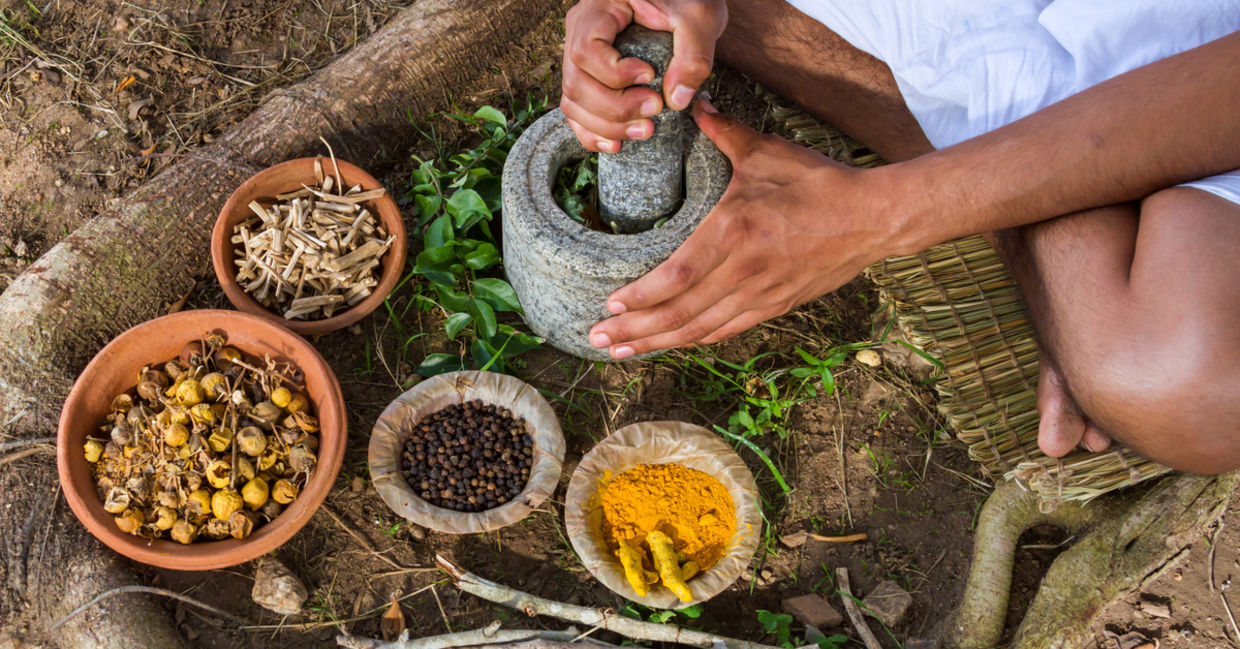
(Nila Newsom / Shutterstock.com)
Centuries ago in Ancient India, sages began developing Ayurvedic medicine. The tradition promotes wellness and fights disease through natural healing. According to Ayurvedic teachings, achieving good health requires balancing the three elemental doshas of vata, pitta, and kapha within ourselves. On the other hand, upsetting the delicate harmony leads to health problems and illness.
The Doshas
Those who practice Ayurvedic medicine believe that each person consists of the five basic elements: space, air, fire, water, and earth. Ayurveda combines the elements into three life forces called doshas. Vata dosha space and air, the pitta dosha has fire and water, and the kapha dosha has water and earth.
Each person has their own unique blend of vata, pitta, and kapha, and usually one of the three doshas is more pronounced than the others. Knowing which dosha dominates reveals how a person, through nutrition and treatments, can balance the doshas and improve health.
The Lively Vata Dosha
Elements: Air and space
Body Functions: Controls functions of the body associated with motion such as blood flow, respiration, the heartbeat, and the movement of thoughts in the mind
Characteristics: People with a strong vata dosha tend to have a lot of energy and creativity, but can easily feel restless and anxious.
How to Balance Vata
Because the vata dosha brings high energy, people can calm this dosha with warm, moist foods. Those with excess vata function best by sticking to a routine and getting a full eight hours of sleep each night.
What to Eat: In general, sweet, sour, and salty foods can ground jumpy vata. People with an abundance of vata should eat sweet treats like fruits, grains, milk, yogurt, and seeds. Sour flavors like lemon, lime, vinegar, and miso promote digestion. Meanwhile, salty foods encourage appetite and help retain water.
What to Avoid: Hot, pungent spices like cumin, garlic, ginger, and paprika tend to disturb vata. Also, rough, bitter foods like kale, saffron, and turmeric can dry out vata.
Fiery Pitta
Elements: Fire and water
Body Functions: Controls metabolism and digestion along with the ability to process life experiences quickly
Characteristics: People with a strong pitta dosha have bold, adventurous personalities and a quick wit, but they can easily become controlling or jealous.
How to Balance Pitta
Those with an excess of pitta tend to feel overheated and irritated easily. Consuming sweet, bitter, and astringent (dry) flavors help to cool, dry, and calm pitta. Pitta governs digestion so people with an abundance of this dosha have big appetites. They need to eat often to feel more balanced.
What to Eat: A diet containing sweet foods like fruits, grains, and milk balances pitta. Bitter foods like kale, bitter melon, dark chocolate, and turmeric also help. Astringent flavors such as dill, fennel, and parsley also harmonize an abundance of pitta.
What to Avoid: Spicy foods like chilies, radishes, and raw onions aggravate pitta. These people should also avoid salt and sour ingredients like vinegar, fermented foods, sour cream, green grapes, and alcohol to stay balanced.
Cool Kapha
Elements: Earth and water
Body Functions: Controls body weight, growth, and moisture
Characteristics: Kapha brings a calming energy, but too much can make someone feel sluggish, overweight, and congested.
How to Balance Kapha
A person with excess kapha can promote health by balancing mucus production, moisture levels, and maintaining body heat.
What to Eat: Fresh ingredients and well-spiced, dry foods help invigorate kapha. Those with an abundance of this dosha should also eat pungent ingredients like chilies, radishes, and raw onions or spices like cloves, garlic, ginger, and paprika. Kapha balances with bitter foods like kale, collard greens, bitter melon, dark chocolate, saffron, and turmeric. Dill, fennel, parsley, and other astringent foods also bring harmony to kapha.
What to Avoid: Sweet foods like fruits, grains, root vegetables, milk, and yogurt slow down kapha even more. Oily or salty foods increase water retention and swelling.
YOU MIGHT ASLO LIKE:
7 of the Best Kept Healthy Habits From the Far East
What Is Your Ayurvedic Health and Body Type? [Quiz]
The Next 5 Superfoods to Try in 2017







